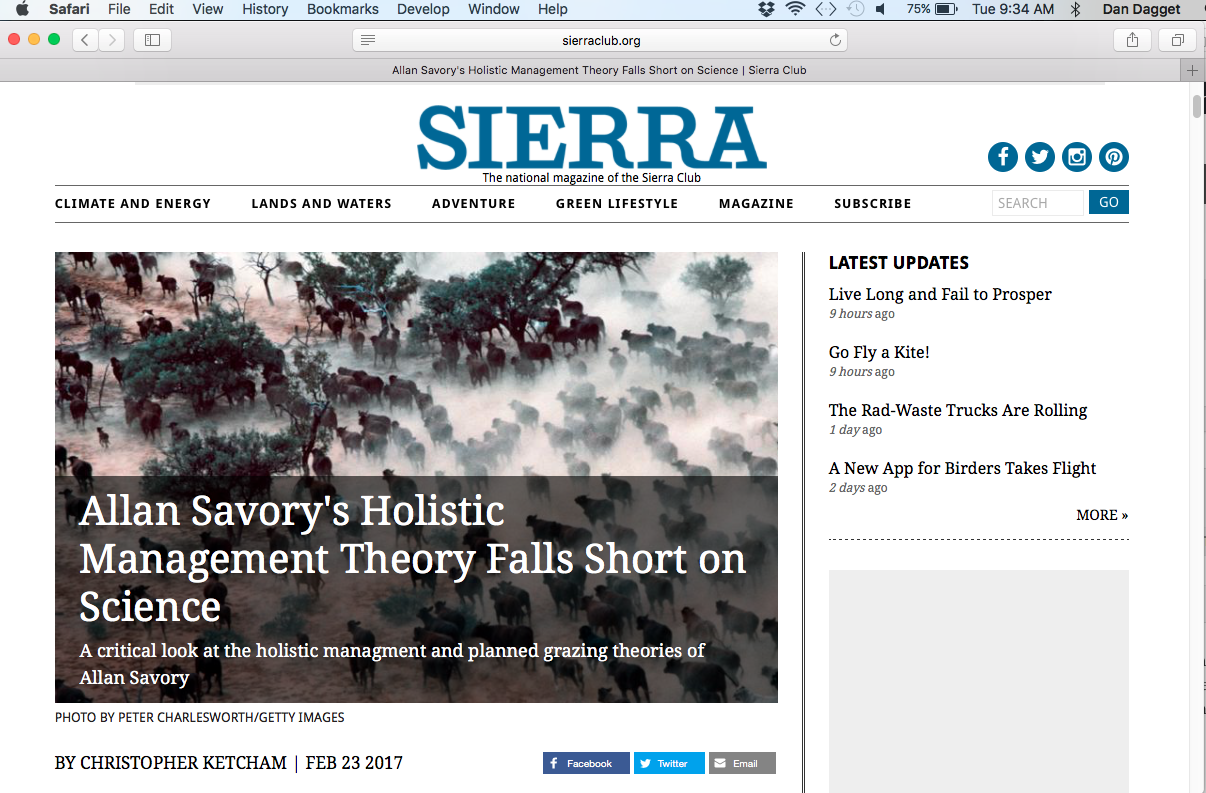
Recently, the Sierra Club (and George Monbiot in the UK newspaper, The Guardian) published articles intended to debunk a means to remedy climate change and other environmental problems that, under most circumstances, would appear to be a natural candidate for support, rather than opposition, from a group that calls itself ”environmental.” For one thing, the remedy this major environmental organization set out to discredit is: simple and down to earth, utilizes skills and activities that have been familiar to humans for millenia, and involves an interaction that ecosystems have used to cycle CO2 as long as life has existed on Earth.
Add to that the fact that the target of this debunking involves no complicated technologies, as do solar and wind power. Nor does it require huge subsidies providing get rich quick scams for companies like Solyndra, all of which, I’m sure you realize, makes it a prime candidate for opposition from not-for-profits that prosper off subsidies, grants, and government funding. (see “EcoProfits” on this website)
What is most interesting about this article, however, is something of which I’m not sure even the author Christopher Ketcham is aware. Ketcham’s article, which is headlined: ”The Sacred Cow — Cows Will Save The Planet… Or Not, You Choose,” provides an opportunity to contrast the foundational axiom of contemporary environmentalism (send us money to grow more government and the environment will be healthy) with a new realization derived from (of all sources) the space program. This comparison-contrast sheds new light on how ecosystems function and the role life-forms, including us humans, play within them. (Maybe I should be thanking Ketcham rather than criticizing him.)
Contemporary environmentalism operates on the principle that all problems in nature result from the impact of humans, and for that reason the way to save the world from climate change, species extinction, desertification—all environmental problems — is to reduce the impact of humans across the board, whether that impact comes from using carbon fuels, grazing livestock, consuming too much, producing too much, reproducing too much, or doing too much of anything except regulation, reduction, and protection.
The space program reveals a fundamental flaw in that reasoning, which we’ll get to as the discussion continues.
The stated reason the Sierra Club published ”The Sacred Cow…” was because Allan Savory — a former ”Provincial Game Officer” in the central African nation now named Zimbabwe ”catapulted into the mainstream” via a TED talk he gave in 2013 entitled ”How To Fight Desertification and Reverse Climate Change.” According to Ketcham, Savory’s talk had garnered 3,746,905 views by the time of the writing of the article. Why this is a cause for alarm for the Sierra Club and a number of other environmental groups is the fact that, as Ketcham put it: ”Savory’s ”environmental apostasy” is based on a controversial idea: that we need more of anything (in this case cows)—not fewer.”
I’m sure there are plenty of you saying, “What’s wrong with that?!” The fact is environmental groups such as the Sierra Club have convinced virtually all of us that the only method to deal with (or remedy) environmental damage of any sort (grazing included) is to support (and contribute to) the product they market — ”protection.” That’s why Savory’s significant success in countering that almost universal assumption has the Sierra Club alarmed. Savory and his ”Holistic Management” technique represent significant competition. How significant? According to Savory, he has convinced tens of thousands of ranchers and farmers around the world to adopt or adapt his techniques on tens of millions of acres of land, and millions of non-ranchers support those techniques.
So, how did Savory come up with such an outrageous idea that more cows rather than fewer are better for the environment? By watching grazing animals, both wild and domesticated (cattle), herded by predators both four and two-legged (maybe a better word is ”herders”) interact sustainably and naturally with the savannahs and grasslands of Central Africa.
In a surprisingly good description of Savory’s Holistic Management, Ketcham writes ”Savory’s theory goes like this: Cows that are managed in the right way can replicate the beneficial effect on soil of the native herds that once covered the planet’s grasslands. Wild herds lived in fear of predators, and for protection they traveled in tight bunches, moving quickly. If we keep cattle moving across the landscape to mimic this behavior, and if we preserve the ancestral grazer-soil relationship—the animals churning the soil with their hooves, fertilizing it with dung and urine, stomping grass (and grass seeds into the soil), creating mulch, stimulating plant growth—we can re-green the arid lands and, at the same time, encourage soil microbes that eat carbon dioxide.”

Or, as Savory put it in his TED talk, his method would: ”use livestock, bunched and moving, as a proxy for former herds and predators, and mimic nature.”
In an odd way that echoes a realization to which space travel (of all things) provided an awakening…
In the 1960s, in advance of sending a probe to Mars, NASA decided it might be a good idea to know in advance if life exists on the Red Planet, so they enlisted a number of scientists to come up with a way to tell if there is life on a planet without (or before) visiting it. Among those scientists was James Lovelock, an English chemist known for thinking out of the box.
Lovelock noted that there are a number of characteristics of our own planet that cannot exist without being sustained in some way (or, in other words, by some thing). For example, there is no way our planet’s atmosphere could stably consist of 21% oxygen (which it does) and thus sustain all the plants and animals living here if left purely to the vagaries of chemistry. Oxygen is a very reactive gas, which means it would quickly react itself into compounds with other chemicals if something wasn’t replacing and sustaining it in its pure or free form. (The atmospheres of Venus and Mars, for instance, contain 0.00 percent and 0.13 percent, respectively, of free oxygen.)
Here on Earth, plants, both on land and sea, produce oxygen as a byproduct of photosynthesis, in other words, as a byproduct of living. What that means is here on Earth living things create and sustain one of the main components of the conditions required for life by, of all things, living.
Lovelock points out that something similar happens in the case of the salinity of the oceans. In spite of the fact that every year roughly 500 million tons of mineral salts are eroded and dissolved from the Earth’s dirt and rocks and carried by streams and rivers into the planet’s oceans, the salinity of those waters remains a surprisingly stable 3.4% and has for a very, very long time. Lovelock considered it no accident that this is exactly the salinity required for the continuing existence of the forms of life that inhabit the seas. (And we’re supposed to worry about a little more CO2!)
To make a long story short (you can read more on your own.) Lovelock hypothesized that the conditions that make life possible here on Earth, have been developed by living things via co-evolution, and those conditions are sustained in a relatively stable form by those same life-forms via the simple, natural act of living. Example? — Bees pollinate flowers as they feed on the nectar within those flowers, which causes seeds to be formed, which creates more plants, which creates food for bees (and other creatures) along with the oxygen that bees and other creatures breathe, which creates more bees and more other creatures, and more flowers, and on, and on…
Ketcham’s description of Savory’s method could easily be taken as a description of Lovelock’s hypothesis… ”Cows that are managed in the right way can help create and sustain the conditions that make life possible on Earth by replicating the beneficial effect on soil of the native herds that once covered the planet’s grasslands… churning the soil with their hooves, fertilizing it with dung and urine, stomping grass (and grass seeds into the soil), creating mulch, stimulating plant growth…”
Lovelock attached the name ”Gaia” (the Greek name for the Earth Goddess) to his hypothesis. No mention of the insights of the Gaia hypothesis or the science upon which it is based, or the relationship of Savory’s method to it, is included, acknowledged, or countered in Ketcham’s litany of quotes of scientists who declare that, “We find all of Mr. Savory’s major claims to be unfounded.”
When Ketcham visited Savory in his home in Albuquerque, New Mexico and began citing ”counterevidence” from this litany of counter-quotes he reports that the visit became ”not as pleasant.” According to Ketcham, Savory responded with photos from instances where his techniques had been applied in South Africa, Botswana, Zambia and Zimbabwe as well as ample testimonials from ranchers, which Ketcham downplayed as ”self-reported and anecdotal,”
At this point I’d like to provide you with some ”self-reported and anecdotal” evidence I have collected or uncovered of applications of Savory’s method or similar methods inspired by the same ”mimicing nature” idea. Then, in accord with Ketcham’s title, ”You Choose.”
First, let’s consider Ketcham’s reference to a 1969 study called the Charter Trials on 6,200 acres in Zimbabwe. Ketcham states that a review of this study revealed that its authors found “no definite evidence in the African studies that short-duration grazing . . . will accelerate plant succession“ and concluded, ”The re-greening from cattle didn’t happen.” (emphasis mine)
In the same vein, Ketcham adds that a group of United States-based rangeland scientists, led by David Briske, a professor in the Department of Ecosystem Science and Management at Texas A&M University, stated flatly that the Savory method “can not green deserts or reverse climate change.” And that Savory’s claims “are not only unsupported by scientific information, but they are often in direct conflict with it.“…. “We find all of Mr. Savory’s major claims to be unfounded.” (Again, no mention of things ”Gaia” and emphasis mine.)
So, let’s conduct a few studies of our own. First let’s visit some land as desertified as any on the planet — a pile of mine waste near a copper mine in central Arizona…
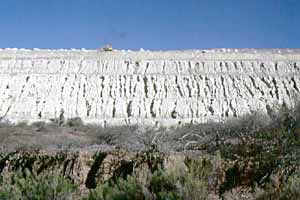
The above photo shows a 300 foot-high pile of mine ”tailings” consisting of rock crushed to the consistency of talcum powder and washed with chemicals, including cyanide, to remove the copper and other minerals. A local range manager with a degree in range science (Terry Wheeler) noticed that, along the edges of this pile, the only manner in which plants were managing to venture onto this wasteland was by growing in the tracks of, and near the dung left by, various animals — deer, coyotes, even an occasional maverick bovine.
Based on these observations Wheeler convinced the mining company to allow him to test his (and thereby Savory’s) theories on their tailings pile by feeding cattle on it. Here are some relevant photos:
 This photo shows the first time cattle were lured down the side of the tailings pile with bails of hay.
This photo shows the first time cattle were lured down the side of the tailings pile with bails of hay.
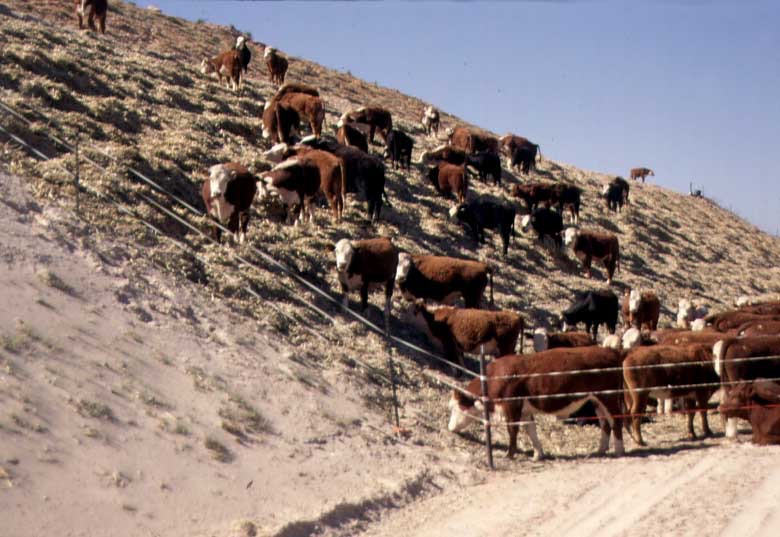 Here’s a more organized application of cattle to mine tailings.
Here’s a more organized application of cattle to mine tailings.
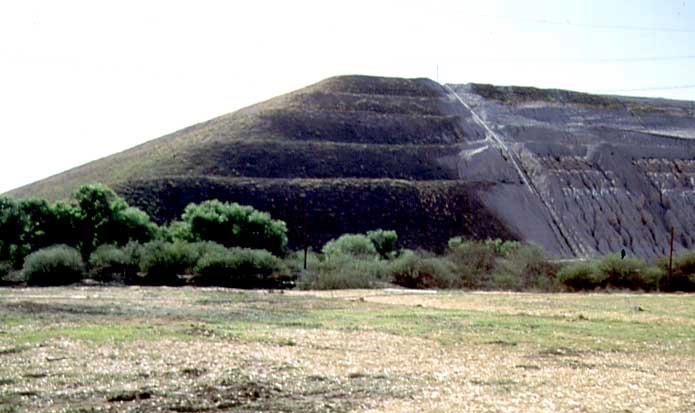
 These “after” photos show how effectively the method based on the principles of Allan Savory and the Gaia hypothesis can “accelerate plant succession and green deserts,” to borrow a few words from Mr. Ketcham, the Charter Trials study and David Briske.
These “after” photos show how effectively the method based on the principles of Allan Savory and the Gaia hypothesis can “accelerate plant succession and green deserts,” to borrow a few words from Mr. Ketcham, the Charter Trials study and David Briske.
 And finally, cows doing a little touch-up work a few years after their initial restoration.
And finally, cows doing a little touch-up work a few years after their initial restoration.
Granted, this isn’t Africa, where the Charter Trials were conducted, but these examples in the mining waste ”deserts” of arid Arizona and (below) Nevada appear to be ”definite evidence” that ”regreening from cattle” does happen, and that Savory’s claims that his method can ”accelerate plant succession” and ”green deserts” are anything but ”unfounded.”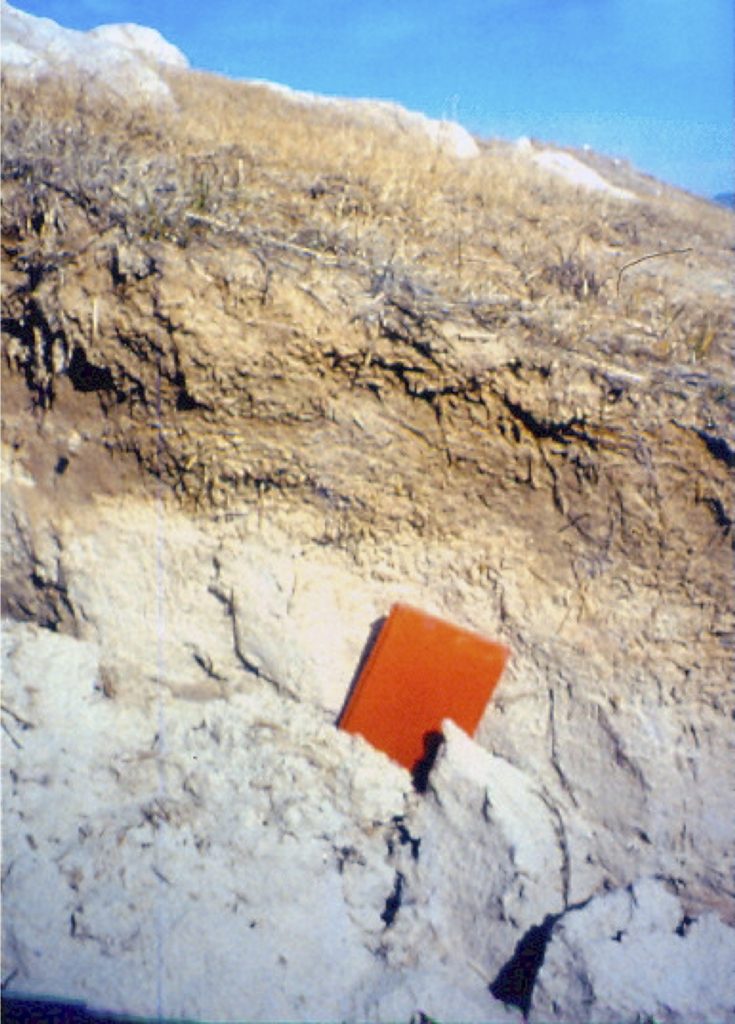
As for ”climate change,” the issue that is so important to contemporary discussions about environmental health, the photo to the right shows with dramatic clarity the degree to which the Savory technique ”sequesters” carbon in the soil. The photo does so by contrasting the dark brown of carbon tilled into the pale, sterile mine tailings by cattle stomping in the mulch of unconsumed hay and manure to be decomposed by microbes added via dung and urine. If you imagine this effect spread, to a significant degree, over the hundreds of millions of acres of rangelands of the West, the statement by Andres Cibils, a professor of range science at New Mexico State University (quoted by Ketcham), that, ”Savory’s claim that… ”increasing the number of cattle on the land,… can boost soil carbon sequestration… also founders under close inspection” does some foundering of its own.
I’ve got lots of photos of restorations like this so I’ve included a few more as collages. The first one shows a restoration completed in central Nevada on a gold mine site where Savory methods succeeded after conventional methods (spread seeds and wait) had failed.
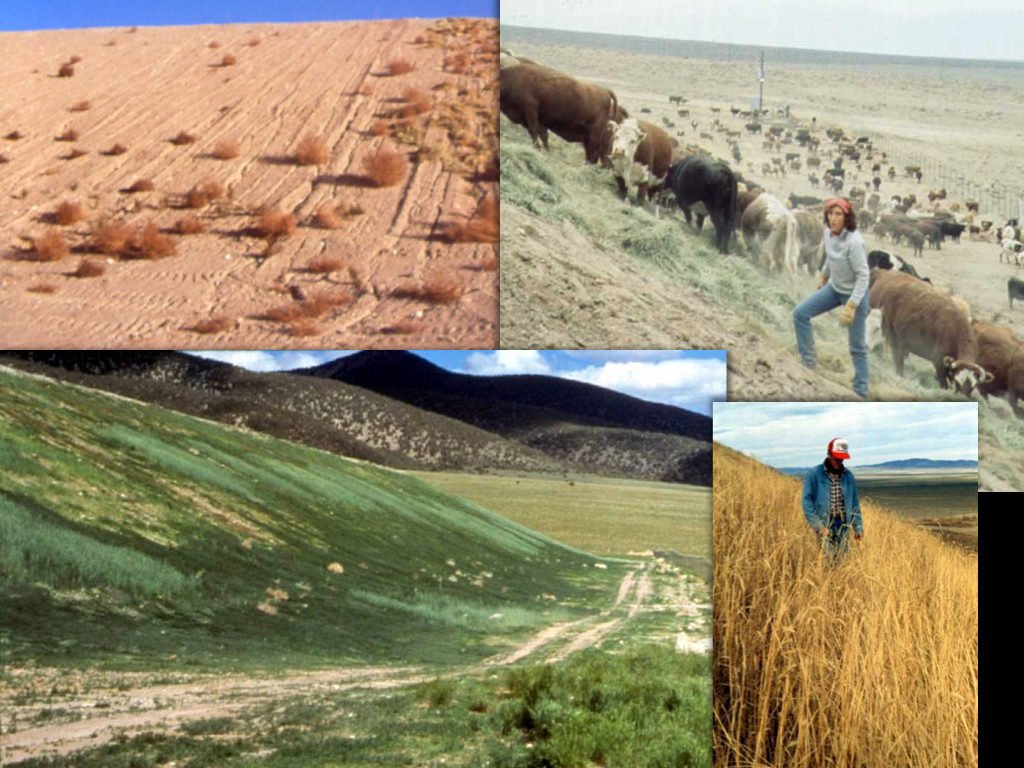
The second sequence was done near my hometown, at the time — Flagstaff, AZ, on a mining pit from which 3 million tons of gravel had been extracted. Conventional methods had failed on part of this site as well.

The examples I’ve just shown you inevitably gives rise to the charge (or more appropriately: the realization) that the studies on which the scientists based the statements quoted by Ketcham have been inadequate, ill designed, and/or too narrow due to ignorance, prejudice, and perhaps advocacy.
I believe the ignorance, prejudice, and/or intention that caused these studies to be so flawed and incorrect can be traced to a basic error in our culture’s most deeply held assumptions about nature (environment, ecosystem — whatever you chose to call it) — about how it functions, what causes it to be healthy or unhealthy, about what it is.
”Cambridge Dictionaries” on the web defines nature as: ”all the animals and plants in the world and all the features, forces, and processes that exist or happen independently of people. Merriam Webster’s definition — (T)he physical world and everything in it (such as plants, animals, mountains, oceans, stars, etc.) that is not made by people.
Within that frame of reference the idea that increasing the number of livestock grazed on a piece of the planet can have a positive ecological effect doesn’t even make sense. It doesn’t make sense because increasing the number of cattle amounts to increasing the impact of humans on nature, thus making it less natural and therefore less healthy and less functional. The fact that the scientists quoted by Ketcham subscribe to this way of thinking is apparent from their (and his) use of the word ”overgrazing.”
“Over” is just another way to say “too much” for which the solution is always “less.”
In the same way that a science based on the traditional definition of nature is automatically biased against Savory’s holistic approach, such a science is also incapable of studying the negative effects of protection. The simple reason for this is, according to the most basic doctrine of such a science, protection returns land to ”nature” by definition, and so, by definition, protection can have no negative effects.
Which brings us to one of Savory’s claims with which the scientists quoted by Ketcham take particular issue — the claim that removing the synergy of grazers and predators (in this case — cows and cowboys) from the world’s grasslands results in the desertification of that land, especially in the case of dry or ”brittle land.”
Talk about a threat to a marketing pitch! If that claim is true, it means that the remedy marketed by environmental groups as the panacea to all that ails the planet — protection — actually increases one of the afflictions to which it is claimed to be the absolute remedy — desertification (and, while we’re at it — climate change). This claim by Savory and some of the people who have applied his methods (that protection causes desertification) has fueled an uproar among all protection-marketing groups (and all protection-funded scientists) since Savory began making it in the 1970s.
Here are some examples of that uproar quoted by Ketcham.
“It’s just wrong,” says Kelsey Brewer, a one-time organic farmer who is now a staff researcher at the University of California, Davis. ”A substantial number of studies on desert grassland have found that with rest, grass cover “increases dramatically,” while “intensive grazing delays this recovery.”
”The Briske team claimed that Savory misrepresented the photos of landscapes he presents as evidence of the alleged desertifying effect of removing cattle.” Regarding one of those photos featuring Chaco Culture National Historical Park in New Mexico, Briske reports that this land, was not desertified from lack of cattle. Instead, the landscape was slowly recovering from decades of abusive overgrazing. (Chaco photo)
OK. Let’s look at some land that Savory would describe as desertified by ”rest” or the removal of the grazing synergy.
First, here’s one of several photos I’ve taken of a U. S. Forest Service Study Area in central Arizona near the site of a town, now a ghost town, named Drake. In 1946 this ”Drake Exclosure” was surrounded by a protective fence to provide an area to study (and illustrate) how effective protection is in enabling land to recover from damage caused by cattle grazing, among other things.
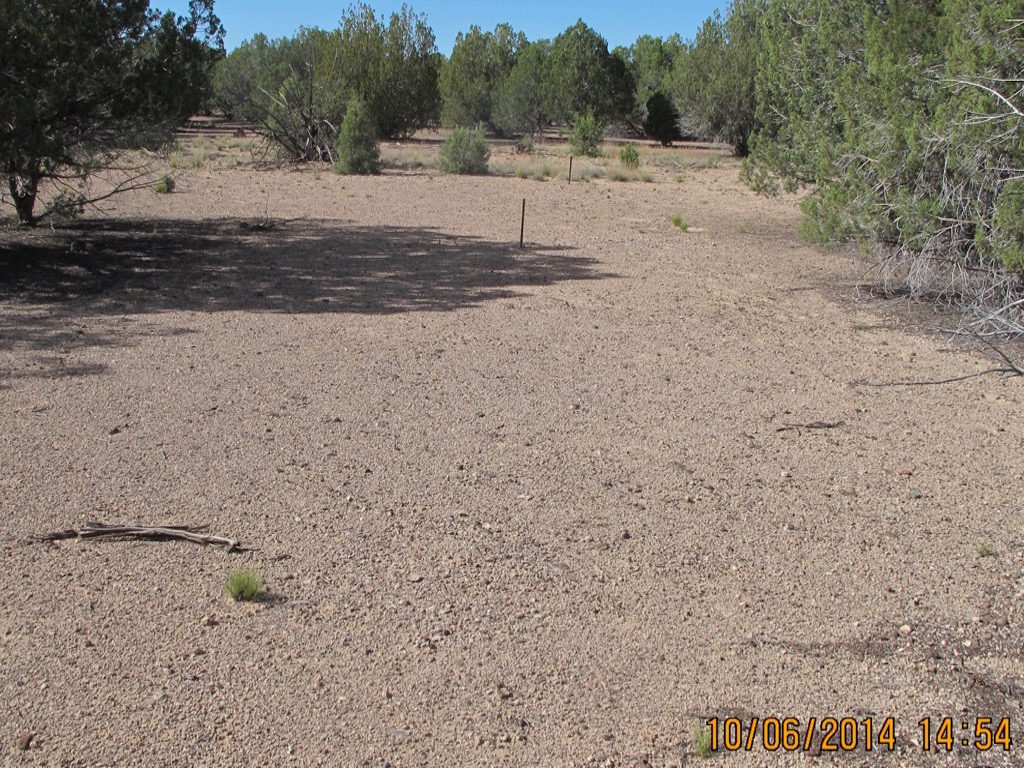
No mistake: This land has been protected since 1946. The above photo was taken in 2014 and shows a monitoring site within the study area. Let’s look at some more monitoring sites on the study area.

These sites are all within the U. S. Forest Service Study Area near Drake, AZ. All have been protected since 1946 (These photos were taken in May of 2016.) The way to read these monitoring sites is count and record the species of the plants that grew in the designated areas (between the stakes or inside the fence.) You can do that to a degree via these photos. While you’re at it, notice that these sites don’t appear to have been read for a while. Why’s that? Would you have the patience to come here once a year over the last 70 years and write down “zero” every year?
While we’re at it here are a couple more study plots on protected land.
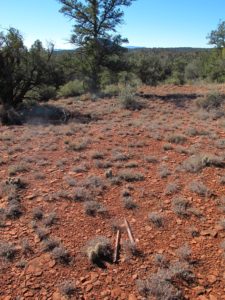 |
 |
The photo on the left shows another USFS study area protected since 1950. Obviously, This site hasn’t been read for a while either. The photo on the right shows a study area on a ranch from which cattle where removed in the mid-1980s. What do these photos tell us about Kelsey Brewer’s quote in Ketcham’s article that Savory’s claim, that protection causes desertification, is “just wrong,” or that “A substantial number of studies on desert grassland have found that with rest, grass cover “increases dramatically?” I believe these photos tell us who is really wrong here, and it’s not Savory.
While we’re reading monitoring sites we should take a look at some sites on grazed areas. For relevance here, we’ll visit areas on which Savory’s principles have been applied. What we’ll be considering here is a statement by Andres Cibils, a professor of range science at New Mexico State University quoted in Ketcham’s article:
Cibils said, “I visited ranchers in New Mexico where Savory has consulted. These are people who tried it and who either modified or abandoned it because the results were a train wreck.”
So, let’s take a look at some monitoring sites on a ranch where the owners/managers are familiar with Savory’s principles and use them to plan their management. Whenever I’m available, I help monitor these sites with a crew which consists of staffers of various government agencies, US Forest Service, Arizona Game and Fish Department, Natural Resource Conservation Service, etc.
And while you’re taking a close look at these monitoring sites remember to apply the same technique I described while you were viewing the photos of monitoring sites on protected land — count the plants that have grown (since this area was grazed a couple of months before) in the area designated by the tapes stretched between the stakes.
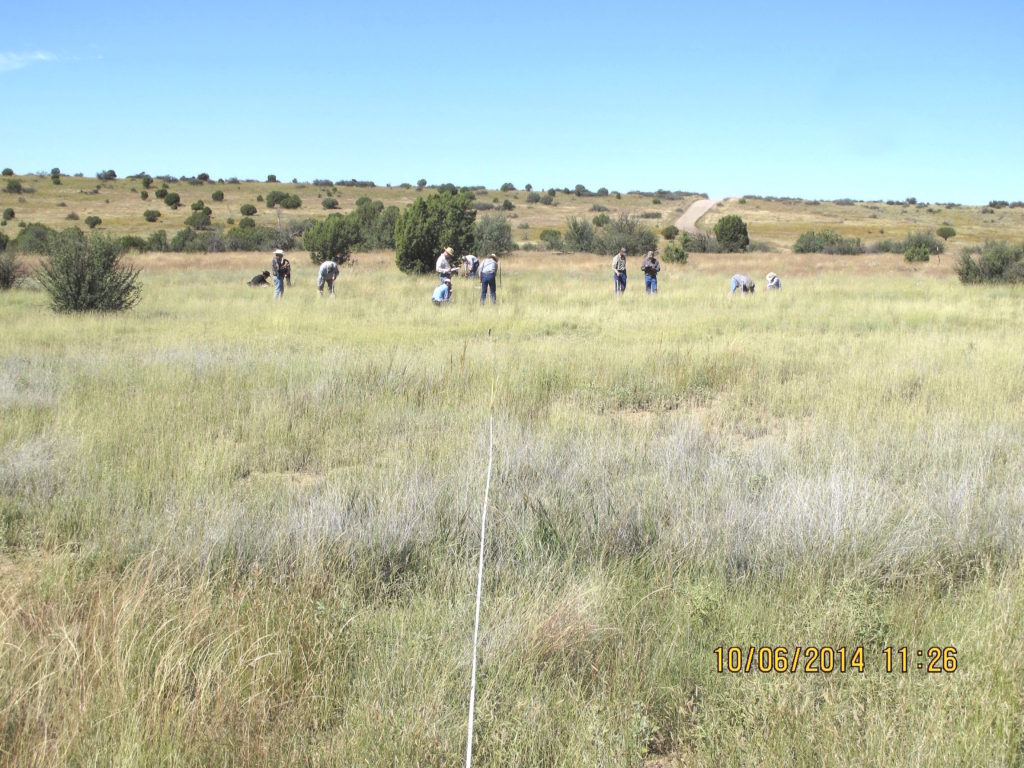
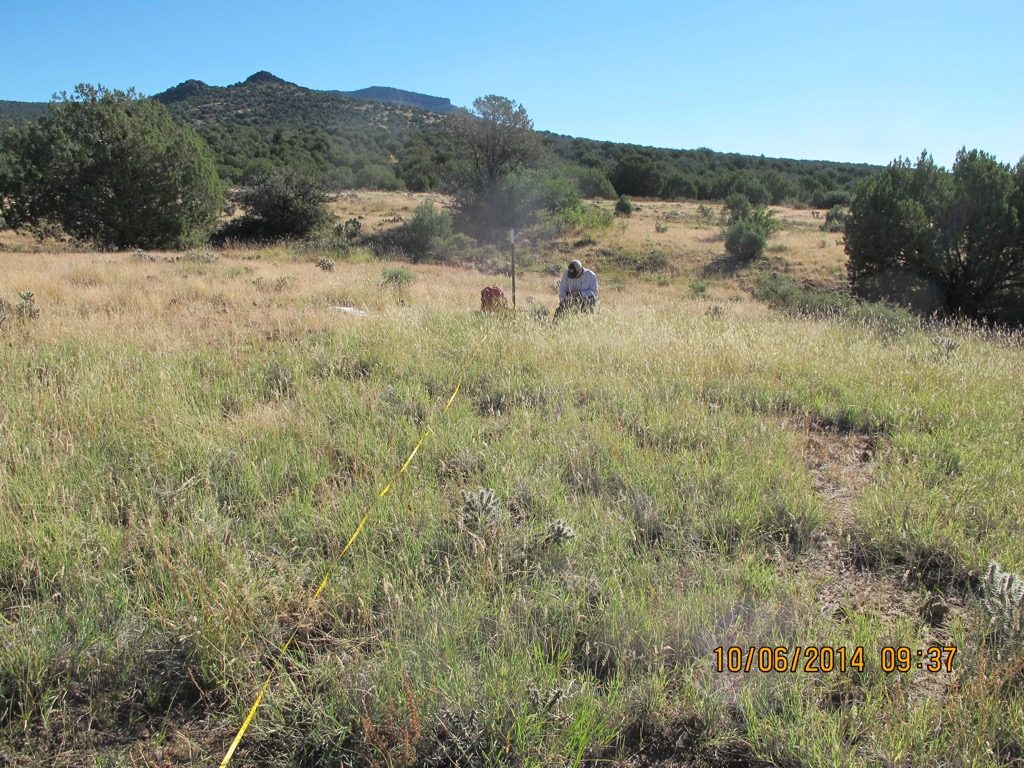
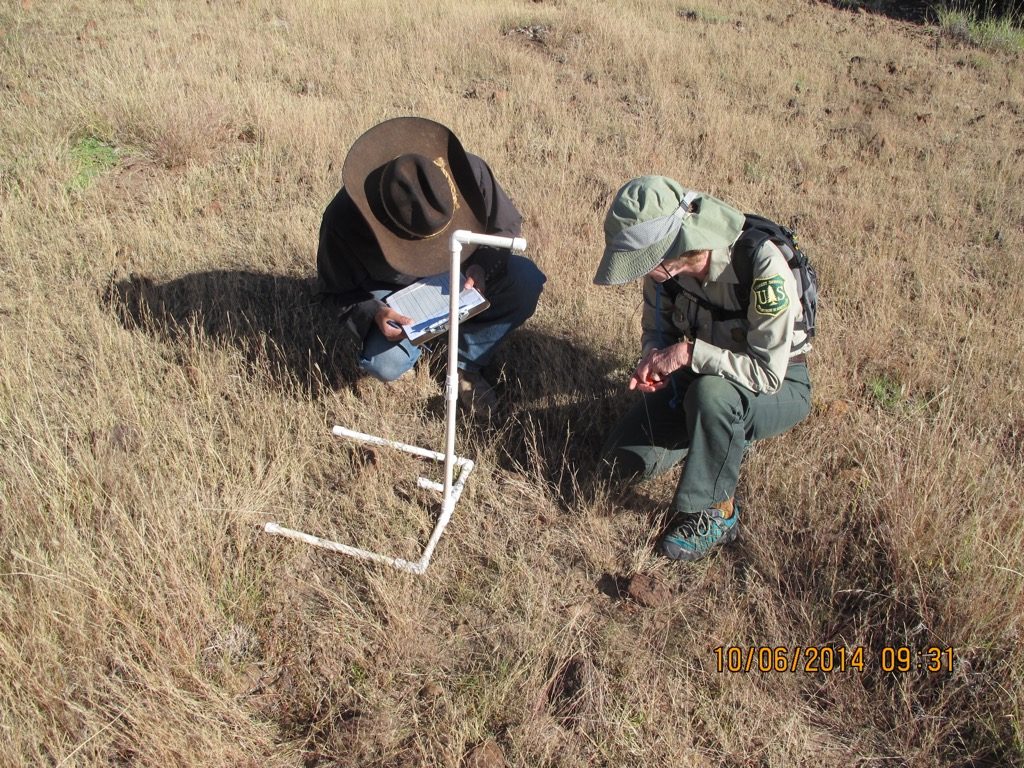
Do these places look like “train wrecks” to you? What light do these examples and others included in this article shed on Cibils’ statement that “there are no credible data to support Savory’s success assertions.” And what about some of the other statements by the scientists quoted in Ketcham’s article?
How about the inference based on ”The Charter Trials” study that there is “no definite evidence that short-duration grazing . . . will accelerate plant succession,” and ”The re-greening from cattle didn’t happen” ?
Or, Texas A&M University professor David Briske’s, statement that the Savory method “can not green deserts or reverse climate change,” and that Savory’s claims “are not only unsupported by scientific information, but they are often in direct conflict with it.”
Based on the evidence shown in these photos it would be more logical (and, in my opinion, more scientific) to conclude that, in the arid American southwest, at least, there is no definite evidence that “protection” . . . accelerates plant succession, regreens deserts, or reverses “Climate Change.”
Nor is there significant evidence that the Savory method doesn’t do all of the above.
So, why did the Sierra Club publish an article designed to take-down, smear, disprove a set of practices that enable humans to work with nature in a manner that benefits both so dramatically, so obviously, so easily? Why would the Sierra Club want to disparage a method that truly can green deserts and reverse desertification, save endangered species (check this link), promote watershed function, in other words can actually achieve all the goals the Sierra Club and other environmental groups have identified as their reason for existing.
One reason was mentioned at the beginning of this article, because Savory and his ”Holistic Management” technique represent a significant threat to the Sierra Club’s marketing pitch that the only true way to deal with (or remedy) environmental damage of any sort (including that caused by grazing) is to support (and contribute to — i. e. buy) the product they market — ”protection.” Few people realize how huge the profits are in this business ironically identified as “Not-For-Profit.” In an article entitled “Eco-Profits, Whose Money Harms the Environment?” I wrote recently for “Range Magazine“ I included:
”Behemoth Big Green even outstrips Big Oil in expendable revenue by orders of magnitude,” writes Ron Arnold in ”Big Green’s Untold Billions,” a 2014 article published on the website of CFACT (Committee For A Constructive Tomorrow) and in the Washington Examiner: ”[T]he American Petroleum Institute’s IRS Form 990 for the most recent year showed $237.9 million in assets while the Natural Resources Defense Council reported $241.8 million.”
In the Christian Science Monitor in a 2012 guest blog, Robert Rapier observes, after ”looking through the financials of a prominent environmental nonprofit’” and discovering ”$250 million in assets, annual donations of more than $100 million, and a dozen employees listed as receiving more than $200,000 a year in compensation,” he thinks ”it is safe to say that environmentalism is indeed a lucrative business for some.”
Thus awakened, I did some looking on my own. In the 2014 annual report of The Nature Conservancy, I found assets listed at more than $5.77 billion. Total support and revenue for that year added up to more than a billion dollars.
The Climate Change campaign is what turns this into a real bonanza. Al Gore’s recent estimate of the cost of averting global warming added up to $15 trillion!
What’s so valuable about the service/product (whatever you want to call it) that the Sierra Club and other environmental groups are selling that so many of us are willing to pump billions and billions (even trillions) of dollars into it. (To make this uncovering most valuable you should occasionally look back over the photos of the results of protection included above as you progress through this list and check this: FOLLOW THE MONEY.)
One reason we contribute money to environmental groups is because doing so identifies us as ”part of the solution” for problems touted to be some of the most serious our species and the planet have ever faced. For instance, by supporting environmental protection, you take a stand as someone willing to protect nature from greedy capitalists who, you’re convinced, want to manipulate (overuse) it to make lots of money while ignoring the fact that they’re exterminating endangered species, overgrazing and decertifying grasslands, overcutting forests, overfishing oceans, increasing invasion by nonnative plants and animals, causing erosion, destroying watersheds and more.
And because you’re protecting wildlife from this alleged eco-holocaust your credentials include the designation as ”friend of plants and animals,” “bunny-hugger,” “vegan,” etc.
Most important of all, by supporting protection you’re fighting Climate Change — global warming — whatever you want to call it, an issue that we are constantly told is the most serious problem threatening humankind today. Some people say it could end all life on the planet.
And talk about a deal! To participate in all of the above you don’t really even have to contribute any money (although you’re certainly expected to). All you have to do is point your finger — blame capitalism, consumerism, climate change deniers, meat eaters; and support protectionist policies, vote the right way, look down on anybody who doesn’t, and don’t forget those contributions!
Note, that what I have just described is of almost incalculable value. Here’s how: It serves as the material for college PHD degrees, professorships, even new departments… It provides the issue-base for the formation of not-for-profits, government bureaucracies (along with endless lists of regulations for those bureaucrats and their staffs to enforce), political campaigns even presidential ones, worldwide treaties, and on and on.
Notice that this economic/political entity is obviously one that doesn’t take kindly to being told that what it does doesn’t work, or (even worse) that something which incorporates the old capitalist ways and produces nothing more than the raw material for a Big Mac works even better.
But what about those abandoned monitoring sites pictured above. One would think that people who are contributing billions and billions to something as important as saving the planet would want to know about the significance of those study plots with nothing growing on them that haven’t been monitored for years? Those studies were supposed to measure, verify, and demonstrate the value of protection as a method to right environmental wrongs.
This leads us to an element of Savory’s Holistic Management method that was totally ignored by Ketcham. An essential part of Savory’s method is the practice of monitoring results to see if what you’re doing is working. The Savory method includes the axiom: ”Assume you are wrong,” because if you assume you are wrong, you’ll keep close track of the results of your actions so you can become aware of how to change what you’re doing when it doesn’t get the results you want..
Savory’s method monitors the physical condition of the land — what and how many plants are growing on it, and what’s their condition? Is organic material (litter) being incorporated into and enriching the soil? Is bare dirt decreasing? Is the water cycle functioning? etc. Within the Savory method, your management has to be sufficently successful to make the land green enough to feed your cows to keep you in business. If what you’re doing isn’t working, the land will tell you that you need to do something different. (But you have to be listening.) Maybe you need to use more cows. Maybe not. Maybe you need to change the duration, time of year, whatever, of your grazing. Land that confirms, via monitoring for results, that it is healthy enough to produce cattle will most likely also be healthy enough to provide wildlife habitat, native plant communities, watershed function, carbon sequestration, and more.
It’s important to note here that I’m not saying environmentalists don’t monitor their results to determine if their methods work or not. They do. But they monitor in terms of how many contributions and memberships they attract, how much public support they gain, how much favorable media coverage they get, how many billion$ in grants they receive (environmental scientists, like the ones Ketcham quotes, especially pay attention to that.) Environmentalists monitor how their point of view plays in the political arena, how many politicians it gets elected (whom they can then rely on to create agencies, bureaucracies and regulations to expand the protectionist economy), how much land they can claim to have “saved”, how much the entire future of the world is considered to depend on what they do, and so forth.
That’s why all those monitoring sites on protected areas have been abandoned. What can they tell you about the values just listed? If you’re a protectionist and you’re applying the method you believe is necessary to save the world, you don’t want to hear that what you’re doing is wrong. In fact you’re convinced that there’s no way you can be wrong — by definition.
And if that restoration doesn’t seem to be happening very quickly, as it is in the case of those monitoring plots and study areas, well, it can’t be protection’s fault. Those barren monitoring plots have to be, as Briske puts it: ”slowly recovering from decades of abusive overgrazing.” In other words, your failure is always your opponent’s fault —by definition.
In light of all this it seems clear that what Ketcham’s article really does is reveal that when it comes to the environment and our efforts to live within it sustainably, we have two sciences. One characterizes the situation as a matter of ”us and them,” defines healthy (or natural) environments as ones that are protected (by ”us” from ”them,” of course) and then comes up with a science which completes the circle — “Healthy environments are ones that are protected, and so the only way to ensure that environments are healthy is to protect them.” Studies that confirm this are reported, those that contradict it are abandoned, and all this is used to market an immense industry, based of course on government — the entity that protects things in our society, that grows unabated by accountability.
Apply this science by definition to the real world happenings illustrated in the photos included in this article (or look at what is really going on with real plants, animals and processes on some real rangeland) and the science of definition is wrong in every case. It is thus revealed as Fake Science by the real science of observation. So, while Fake Science serves as an indispensible sales tool for the ”billion$ and billion$” economy of ”us versus them” Fake Green — an economy, which is arguably causing more harm to the ecos than capitalism, it doesn’t serve very well as a tool for guiding effective or sustainable land management.
Apply the science that is an outgrowth of the space program — James Lovelock’s Gaia Theory — to those same real world, photo-illustrated happenings, and everything makes perfectly good sense. The photos of areas grazed by cattle managed in line with Savory’s insights are green and healthy because living things, including cattle and humans are interacting in a way that benefits both. Humans are acting as predators, cows are prey, humans are herding and moving cattle, who are harvesting, recycling, seeding, tilling, and fertilizing. The result is a prosperity that benefits more than cows and humans. It benefits deer, rabbits, mice, fish, birds, bugs, plants, microbes, the list is longer than I have room to include here.
When seen through this Gaia science lens, those barren protected areas and abandoned study plots, make perfectly good sense, too . Within those barren areas the most significant predators, prey, circulators, harvesters, recyclers, seeders, tillers, and fertilizers (humans and cows) have been removed, and where the interaction of living things has been reduced, so have the conditions to support life and, thus, so has life itself.
Getting back to the positive, the alternative to Fake Green and Fake Science, provided by Lovelock’s Gaia and Savory’s Holistic Management, evaluates environmental health according to description rather than definition, sets a goal that is a matter of results rather than rhetoric (concrete, ecological results, at that), and then confirms success as a matter of the achievement of those results rather than as a matter of “us versus them.”
Sounds more sustainable to me.
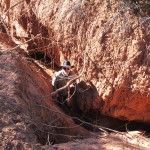


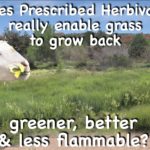
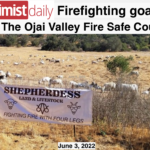
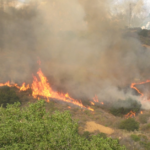
Fantastic article, thanks.